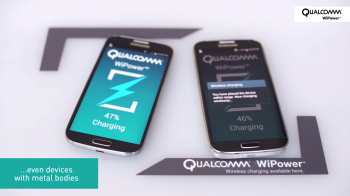
Qualcomm’s wireless charging solution is better, faster, stronger, than Qi – and now it goes through metal
While convenient for consumers, one of the bigger challenges OEMs face when building phones with wireless charging is that they’re limited to using either glass or plastic on the backs of their devices. Wireless charging standards like Qi and PMA don’t exactly play nice with metal, which is why you wont find wireless charging on an aluminum clad phones like the HTC One M9 or iPhone 6. But that could soon change.
Qualcomm’s been developing their own wireless charging solution for awhile now. Dubbed WiPower, we first saw it almost 2 years ago. Today, they’ve made a new development that makes it even more convenient than ever before — WiPower can finally go through metal. Although you wont find WiPower on any current devices, it’s sure to come bundled inside premium smartphones looking to take advantage of the tech in the near future. Steve Pazol, General Manager of Wireless Charging, Qualcomm Incorporated had this to say:
“Today, more device manufacturers are choosing to utilize metal alloys in their product designs to provide greater structural support and, of course, aesthetics. QTIs engineering advancement eliminates a major obstacle facing wireless power and opens up the continued adoption of this desirable feature to a much wider range of consumer electronics and use cases.”
Based on Near Field Magnetic Resonance technology, WiPower is designed to be Rezence compliant and although it wasn’t mentioned in their press release, doesn’t sound like it will support Qi or PMA charging methods. On the upside, WiPower is faster and far more convenient than current wireless charging solutions by being able to charge devices quicker (it can pump out up to 22 watts of power), and offers more flexibility by eliminating the need for precise alignment and/or physical contact with a receiving device. It’s basically what wireless charging always should have been.
In their demo video, you can Qualcomm haphazardly throw a pile of smartphones retrofitted with WiPower onto a charging plate. No need to line up devices perfectly, and it doesn’t even matter that they’re not in direct contact with the surface. Wow. Qualcomm also mentions that it can even charge multiple devices even if they require different power requirements) and uses Bluetooth Smart to further help minimize hardware requirements.
OEMs can begin licensing the new tech now, with a full suite of WiPower reference designs available to them. We’re sure we’ll see more about WiPower in the coming months, be it the next big trade show or otherwise. We want this, like, yesterday.